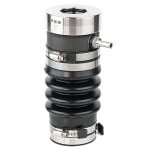
The PSS Shaft Seal is a mechanical face seal that is created between the flat surfaces of the rotating stainless steel rotor and the stationary carbon flange. The stationary carbon flange is attached to the vessels stern tube with hose clamps and the carbon flange is attached to the front side of the bellows with hose clamps. The stainless steel rotor is fit on the shaft in front of the carbon flange. The stainless steel rotor is used to compress the bellows before the collar is secured to the shaft with set-screws. This compression (pre-load) maintains contact between the faces and allows the PSS to compensate for the thrust from the propeller. The carbon flange is bored larger than the shaft diameter allowing it to “float” around the shaft and thus compensate for most misalignment and vibration problems. The stainless steel collar is sealed to the shaft by two o-rings that are recessed into the bore of the collar. These o-rings rotate with the shaft and stainless steel rotor and do not experience wear during operation.
The Packless Sealing System
(PSS) Shaft Seal is a mechanical face seal that is created betwee..
The Packless Sealing System
(PSS) Shaft Seal is a mechanical face seal that is created betwee..
The Packless Sealing System
(PSS) Shaft Seal is a mechanical face seal that is created betwee..
The Packless Sealing System
(PSS) Shaft Seal is a mechanical face seal that is created betwee..
The Packless Sealing System
(PSS) Shaft Seal is a mechanical face seal that is created betwee..
The Packless Sealing System
(PSS) Shaft Seal is a mechanical face seal that is created betwee..
The Packless Sealing System
(PSS) Shaft Seal is a mechanical face seal that is created betwee..
The Packless Sealing System
(PSS) Shaft Seal is a mechanical face seal that is created betwee..
The Packless Sealing System
(PSS) Shaft Seal is a mechanical face seal that is created betwee..
Showing 1 to 9 of 9 (1 Pages)



